Hydrocarbon Accumulation Stages in the Huhehu Sag, Hailar Basin, China
Abstract
1. Introduction
2. Regional Geological Setting
3. Materials and Methods
4. Results
4.1. Determination of Hydrocarbon Accumulation Period Through Source Rock Generation-Expulsion History
4.2. Determination of Hydrocarbon Accumulation Using Authigenic Illite Dating Method
4.3. Determination of Hydrocarbon Accumulation Period Using Homogenization Temperatures of Reservoir Fluid
5. Discussion
6. Conclusions
Author Contributions
Funding
Data Availability Statement
Conflicts of Interest
References
- Hao, F.; Zou, H.Y.; Jiang, J.Q. Dynamics of petroleum accumulation and its advances. Earth Sci. Front. 2000, 7, 11–22. [Google Scholar]
- Xin, R.C.; Tian, C.Z.; Dou, T.J. Study of oil-pool-forming chronology. Earth Sci. Front. 2000, 7, 48–54. [Google Scholar]
- Jiang, Z.X.; Pang, X.Q.; Huang, Z.L. A method for studying the oil and gas migration stages in superposed basin and its application. Oil Explor. Dev. 2000, 27, 22–25. [Google Scholar]
- Ren, Z.L.; Cui, J.P.; Feng, J.H.; Ren, L.Y.; Liu, L. Research on formation stages of hydrocarbon reservoirs in Qiaokou area of Dongpu depression. Oil Explor. Dev. 2002, 29, 15–18. [Google Scholar]
- Ren, Z.L.; Feng, J.H.; Cui, J.P.; Ren, L.Y. Formation stages of natural gas reservoirs in Duqiaobai area of Dongpu depression. Oil Gas Geol. 2002, 23, 376–381. [Google Scholar]
- Zhao, M.J.; Song, Y.; Pan, W.Q.; Han, J.F.; Liu, S.B.; Qin, S.F. The overall approach of hydrocarbon filling periods and process in sedimentary basins. Adv. Earth Sci. 2004, 19, 939–946. [Google Scholar]
- Liu, G.D.; Zhang, Z.P.; Chen, W.X.; Chen, W.L.; Lin, S.Q. Study on the period and time of oil and gas accumulation in Yanqi basin, Northwest China. Oil Explor. Dev. 2002, 29, 69–71. [Google Scholar]
- Xiao, H.; Ren, Z.L.; Cui, J.P. Studies of accumulation stages of Silurian gas-bearing reservoirs in well Kongqu 1 in the Tarim basin. Pet. Geol. Exp. 2008, 30, 357–362. [Google Scholar]
- Suggate, R.P. Relations between depth of burial, vitrinite reflectance and geothermal gradient. J. Pet. Geol. 1998, 21, 5–32. [Google Scholar] [CrossRef]
- Sweeney, J.J.; Burnham, A.K. Evaluation of a simple model of vitrinite reflectance based on chemical kinetics. AAPG Bull. 1990, 74, 1559–1570. [Google Scholar] [CrossRef]
- Gallagher, K. Evolving temperature histories from apatite fission-track data. Earth Planet. Sci. Lett. 1995, 136, 421–435. [Google Scholar] [CrossRef]
- Muirhead, D.K.; Bond, C.E.; Watkins, H.; Butler, R.W.H.; Schito, A.; Crawford, Z.; Marpino, A. Raman Spectroscopy: An effective thermal marker in low temperature carbonaceous fold-thrust belts. Geol. Soc. Lond. Spec. Publ. 2019, 490, 135–151. [Google Scholar] [CrossRef]
- Sanità, E.; Di Rosa, M.; Lardeaux, J.M.; Marroni, M.; Tamponi, M.; Lezzerini, M.; Pandolfi, L. Deciphering the pressure–temperature path in low-grade metamorphic rocks by combining crystal chemistry, thermobarometry and thermodynamic modelling: An example in the Marguareis Massif, Western Ligurian Alps, Italy. Miner. Mag. 2025, 89, 203–224. [Google Scholar] [CrossRef]
- Ren, Z.L.; Qi, K.; Yang, G.L.; Cui, J.P.; Yang, P.; Wang, K. Research status and existing problems of relationship between deep thermal evolution history and oil and gas in sedimentary basins. Unconv. Oil Gas. 2020, 7, 1–7. [Google Scholar]
- Zhang, X.D.; Liu, G.D.; Wang, J.L. Structural Characters of the Hailar Basin and Its Geological Evolution. Pet. Geol. Exp. 1994, 16, 119–127. [Google Scholar]
- Zhang, Y.Q.; Zhao, Y.; Dong, S.W.; Yang, N. Tectonic evolution stages of the Early Cretaceous rift basins in Eastern China and adjacent areas and their geodynamic background. Earth Sci. Front. 2004, 11, 123–133. [Google Scholar]
- Lu, S.F.; Liu, X.Y.; Qu, J.Y.; Wang, Z.W. Restoring of Original Hydrocarbon Potential and Original Organic Carbon of Source Rocks in Huhehu Depression of Hailar Basin. J. Northeast Pet. Univ. 1995, 19, 31–34. [Google Scholar]
- Lu, S.F.; Wang, Z.W.; Chen, X. Application of Kinetic Method on Hydrocarbon Generation to Evaluation Source Rocks in Huhehu Depression. Explorationist 1997, 2, 41–46. [Google Scholar]
- Cui, J.P.; Ren, Z.L.; Xiao, H. Relations between the Thermal History and Petroleum Generation in the Huhehu Depression, Hailar basin. Geol. China. 2007, 34, 522–527. [Google Scholar]
- Wang, P.J.; Zhong, J.H.; Niu, Y.B. Tectonic Feature and Evolution of Huhehu Depression in Hailar Basin. Spec. Oil Gas Reserv. 2009, 16, 25–27. [Google Scholar]
- Liu, H.Y. The Evalution of Hydrocarbon Source Rock in Huhehu Depression. Master’s Thesis, Northeast Petroleum University, Daqing, China, 2010; pp. 8–34. [Google Scholar]
- Lu, K.; Hou, D.J.; Hong, H.F.; Cao, H.M. Geochemical Characteristics of Crude Oil and Correlation of Oil Source in Huhehu Sag. J. Guilin Univ. Technol. 2010, 30, 28–32. [Google Scholar]
- Shen, W.J. Geochemical Characteristics and the Origin of Gas from He 10 Well, Huhehu Depression in Hailar Basin. Nat. Gas Explor. Dev. 2010, 33, 22–26. [Google Scholar]
- Li, J.H.; Lu, S.F.; Meng, Q.A.; Cao, R.C.; Zhu, D.F.; Liu, H. Tectonic Evolution and Its Controlling on Hydrocarbon of Huhehu Depression in Hailar Basin. Chin. J. Geol. 2011, 46, 929–941. [Google Scholar]
- Wu, C.B.; Li, J.H. Sequence Stratigraphic Geochemistry and Its Application to the Evaluation of Source Rocks of Huhehu Sag in Hailar Basin. Acta Geol. Sin. 2012, 86, 661–670. [Google Scholar]
- Liu, S.G.; Luo, Z.L.; Zhao, X.K.; Long, X.M.; Wang, D.N.; Zhang, E.H.; Li, A.F. Studying the Evolution of the Hailaer Basin, NeiMengGu. J. Chengdu Coll. Geol. 1993, 20, 78–86. [Google Scholar]
- Chen, J.L.; Wu, H.Y.; Zhu, D.F.; Lin, C.H.; Yu, D.S. Tectonic Evolution of the Hailar Basin and Its Potentials of Oil-gas Exploration. Chin. J. Geol. 2007, 42, 147–159. [Google Scholar]
- Sanità, E.; Conconi, R.; Lorenzon, S.; Di Rosa, M.; Capitani, G.; Mugnaioli, E. Application of an improved TEM-EDS protocol based on charge balance for accurate chemical analysis of sub-micrometric phyllosilicates in low-grade metamorphic rocks. Clays Clay Miner. 2024, 72, 1–11. [Google Scholar] [CrossRef]
- Hamilton, P.J.; Kelley, S.; Fallick, A.E. K-Ar dating of illite in hydrocarbon reservoirs. Clay Miner. 1989, 24, 215–231. [Google Scholar] [CrossRef]
- Wang, F.Y.; Hao, S.S.; Lei, J.J. The isotopic dating of authigenic illite and timing of hydrocarbon fluid emplacement in sandstone reservoir. Acta Pet. Sin. 1998, 19, 40–43. [Google Scholar]
- Zhang, Y.Y.; Luo, X.Q.; Song, J. Discussions on K-Ar isotopic geochronological studies of authigenic illites in hydrocarbon reservoirs. Geoscience 2002, 16, 403–407. [Google Scholar]
- Hunt, J.M.; Lewan, M.D. Modeling oil generation with time-temperature index graphs based on the Arrhenius equation. AAPG Bull. 1991, 75, 795–807. [Google Scholar] [CrossRef]
- Xu, S.H.; He, S.; Yuan, C.P. A simulation model of histories of evolution and hydrocarbons generation and expulsion of source rock. Earth Sci.-J. China Univ. Geosci. 1995, 20, 335–341. [Google Scholar]
- He, C.; Zhang, L.J.; Wang, Q.; Ma, Z.L.; Ma, J.F. Experiment development and application of source rock thermal simulation for hydrocarbon generation and expulsion. Pet. Geol. Exp. 2021, 43, 862–870. [Google Scholar]
- Wang, H.J.; Cai, Y.C. Applications of general characteristics of fluid inclusions to the study of oil and gas pool formation. Oil Explor. Dev. 2000, 27, 50–52. [Google Scholar]
- Liu, S.B.; Gu, J.Y. Analytical methods of fluid inclusions and applications to the study of oil and gas. Oil Explor. Dev. 1997, 24, 29–33. [Google Scholar]
- Zhang, M.J.; Tang, J.H.; Zhang, T.W.; Lv, Z.G.; Yang, R.S. Applications of Fluid Inclusions to Petroleum and Natural Gas Geology and Geochemistry. Geol. Rev. 2004, 50, 397–406. [Google Scholar]
- Liewig, N.; Clauer, N.; Sommer, F. Rb-Sr and K-Ar Dating of Clay Diagenesis in Jurassic Sandstone Oil Reservoir, North Sea1. AAPG Bull. 1987, 71, 1467–1474. [Google Scholar]
- Wang, F.Y.; He, P.; Zhang, S.C.; Zhao, M.J.; Lei, J.J. The K-Ar isotopic dating of authigenic illites and timing of Hydrocarbon fluid emplacement in sandstone reservoir. Geol. Rev. 1997, 43, 541–545. [Google Scholar]
- Ren, Z.L.; Liu, L.; Cui, J.P.; Xiao, H.; Gao, S.L. Application of tectoni-thermal evolution history to hydrocarbon accumulation timing in sedimentary basins. Oil Gas Geol. 2008, 29, 502–506. [Google Scholar]
- Ren, Z.L. Research on the relations between geothermal history and oil-gas accumulation in the Ordos basin. Acta Pet. Sin. 1996, 17, 17–24. [Google Scholar]
- Ren, Z.L.; Liu, C.Y.; Zhang, X.H.; Wu, H.N. Research on the relations between geothermal history and oil-gas generation in Jiudong basin. Acta Sedimentol. Sin. 2000, 18, 619–623. [Google Scholar]
- Qiu, N.S. Thermal evaluation and hydrocarbon generation history of the sedimentary basins in western China. Oil Explor. Dev. 2002, 29, 6–8. [Google Scholar]
- Ren, Z.L.; Liu, C.Y.; Pu, R.H.; Li, J.B.; Feng, J.H. Research on geothermal history of Bayindoulan depression in Erlian basin. Acta Pet. Sin. 2000, 21, 42–45. [Google Scholar]
- Sykes, R.; Snowdon, L.R. Guidelines for assessing the petroleum potential of coaly source rocks using Rock-Eval pyrolysis. Org. Geochem. 2002, 33, 1441–1455. [Google Scholar] [CrossRef]
- Opera, A.; Alizadeh, B.; Sarafdokht, H.; Janbaz, M.; Fouladvand, R.; Heidarifard, M.H. Burial history reconstruction and thermal maturity modeling for the middle cretaceous–Early miocene petroleum System, southern Dezful Embayment, SW Iran. Int. J. Coal Geol. 2013, 120, 1–14. [Google Scholar] [CrossRef]
- Cui, J.P.; Zhao, J.; Ren, Z.L.; Jin, W.; Xing, L.; Wang, Y.Q. Geochemical Characteristics of Lower Cretaceous Source Rocks and Thermal History in the Huhehu Depression, Hailar Basin. Earth Sci. 2020, 45, 238–250. [Google Scholar]
- Dong, L.; Wang, W.M.; Yu, X.B.; Wang, G.H. Study on Hydrocarbon Accumulation Stages in Nantun Formation, Huhehu Depression, Hailaer Basin. Pet. Geol. Recovery Effic. 2011, 18, 20–23. [Google Scholar]
- Zhou, J.B.; Zhang, X.Z.; Ma, Z.H.; Liu, L.; Jin, W.; Zhang, M.S.; Wang, C.W.; Chi, X.G. Tectonic Frame Work and Basin Evolution in Northeast China. Oil Gas Geol. 2009, 30, 530–538. [Google Scholar]
- Zhang, X.Z.; Guo, Y.; Zeng, Z.; Fu, Q.L.; Pu, J.B. Dynamia Evolution of the Mesozoic-Cenozoic Basins in the Northeastern China. Earth Sci. Front. 2015, 22, 88–98. [Google Scholar]
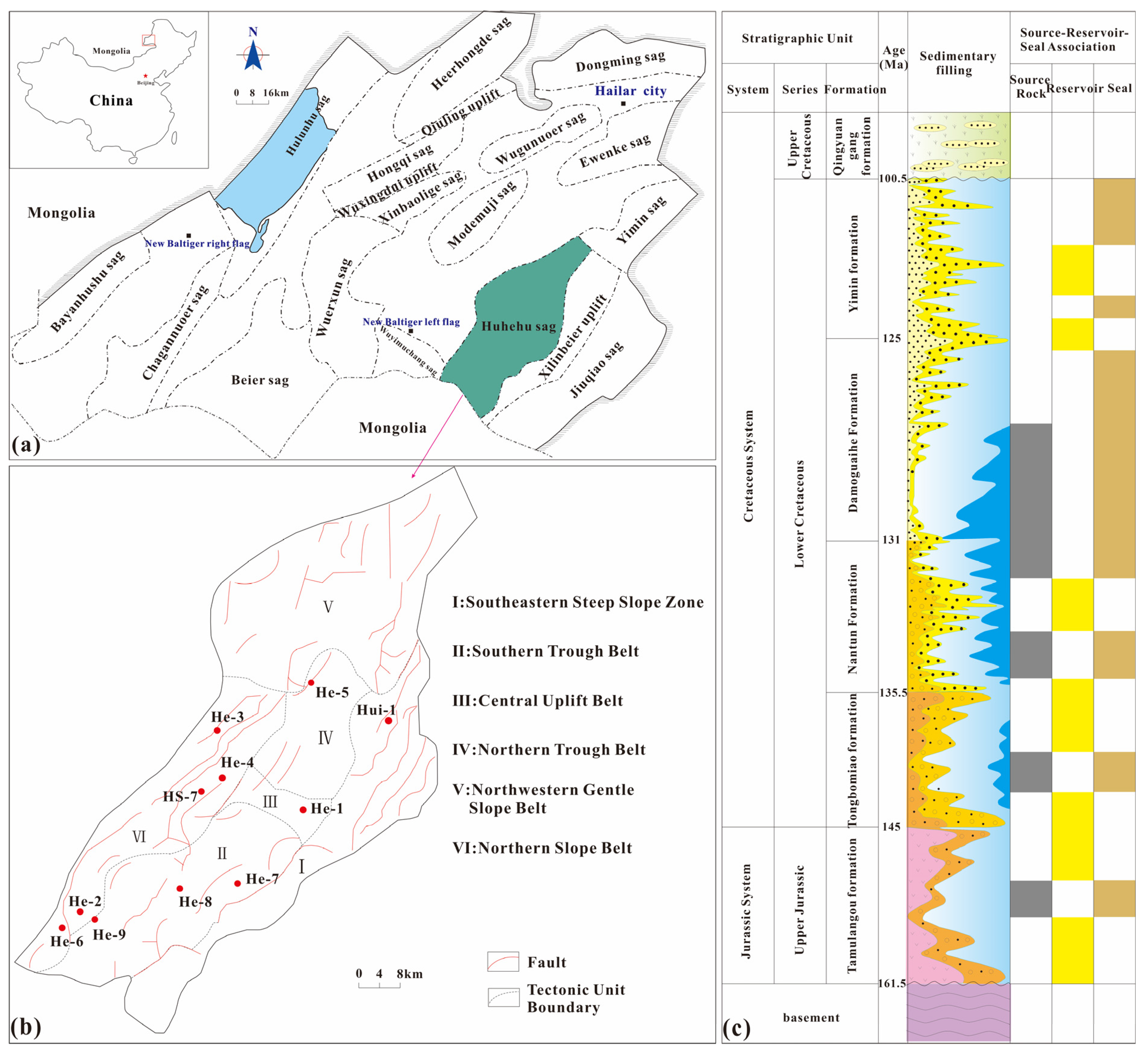

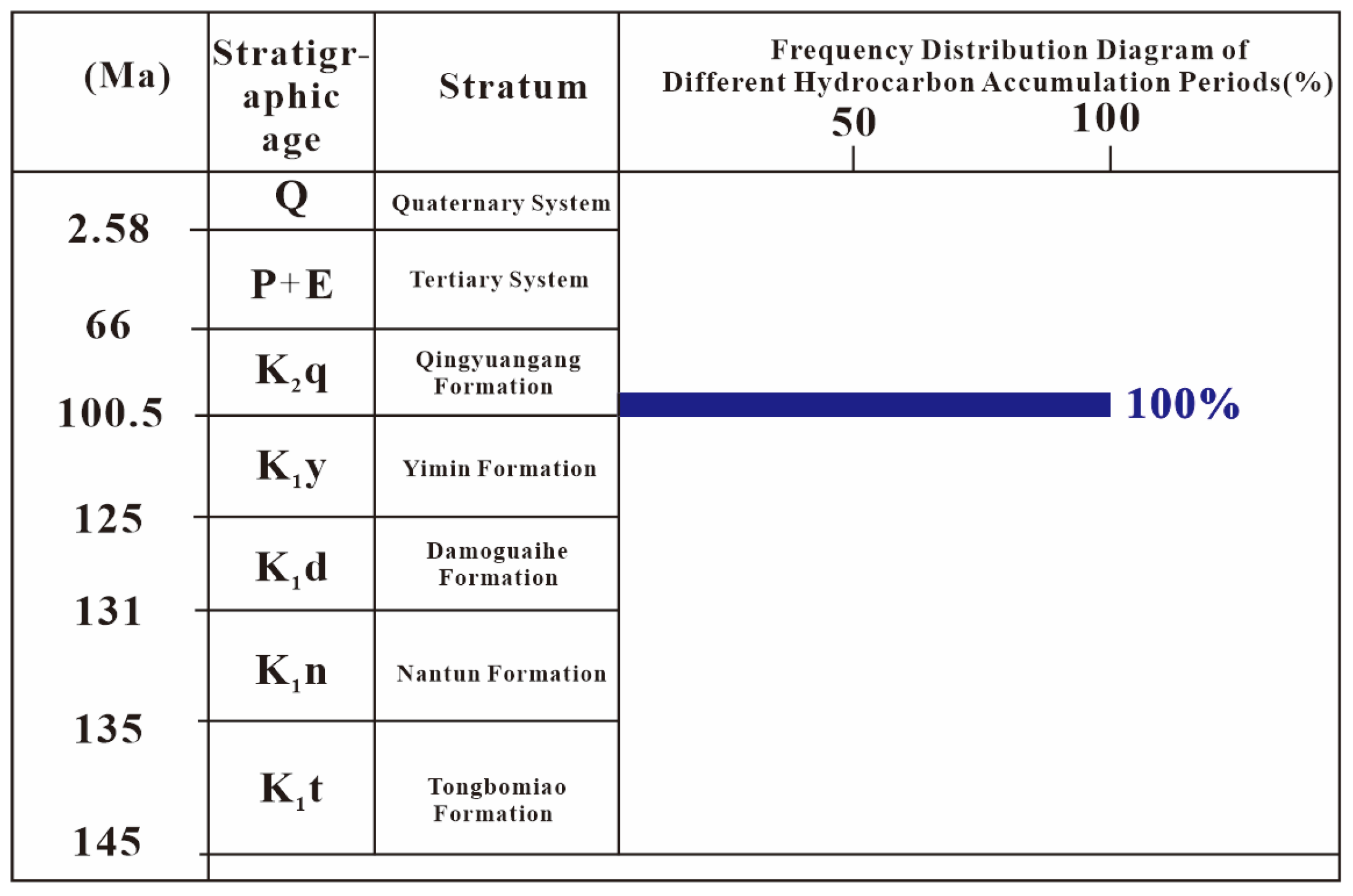
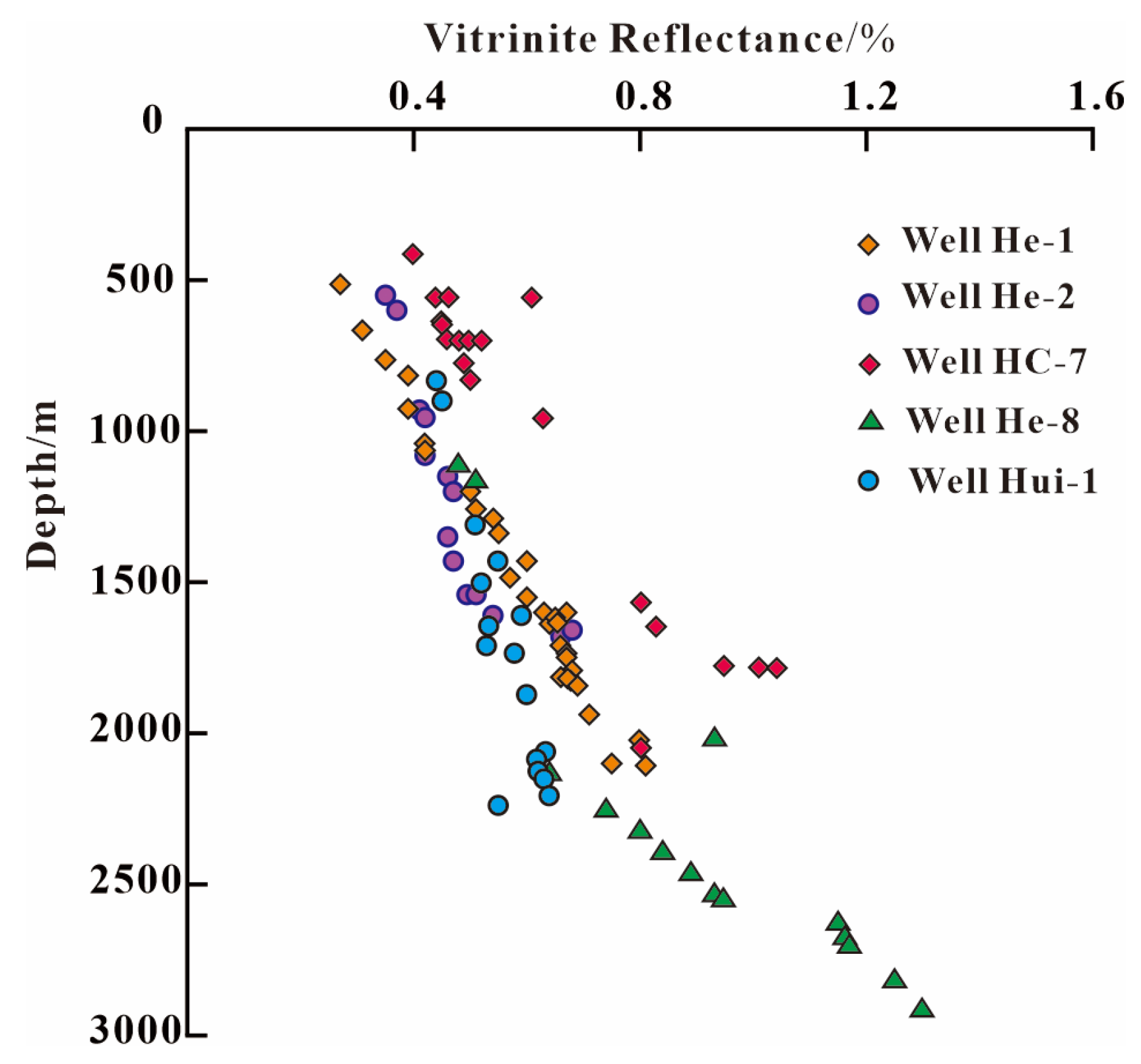
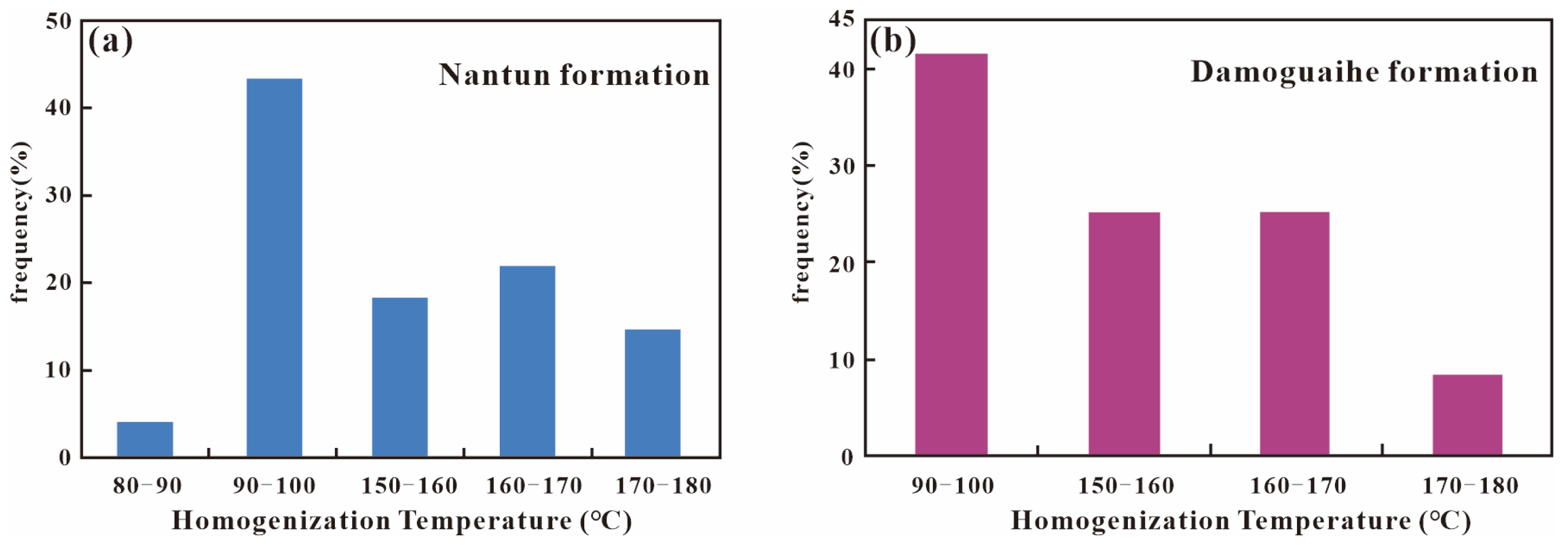
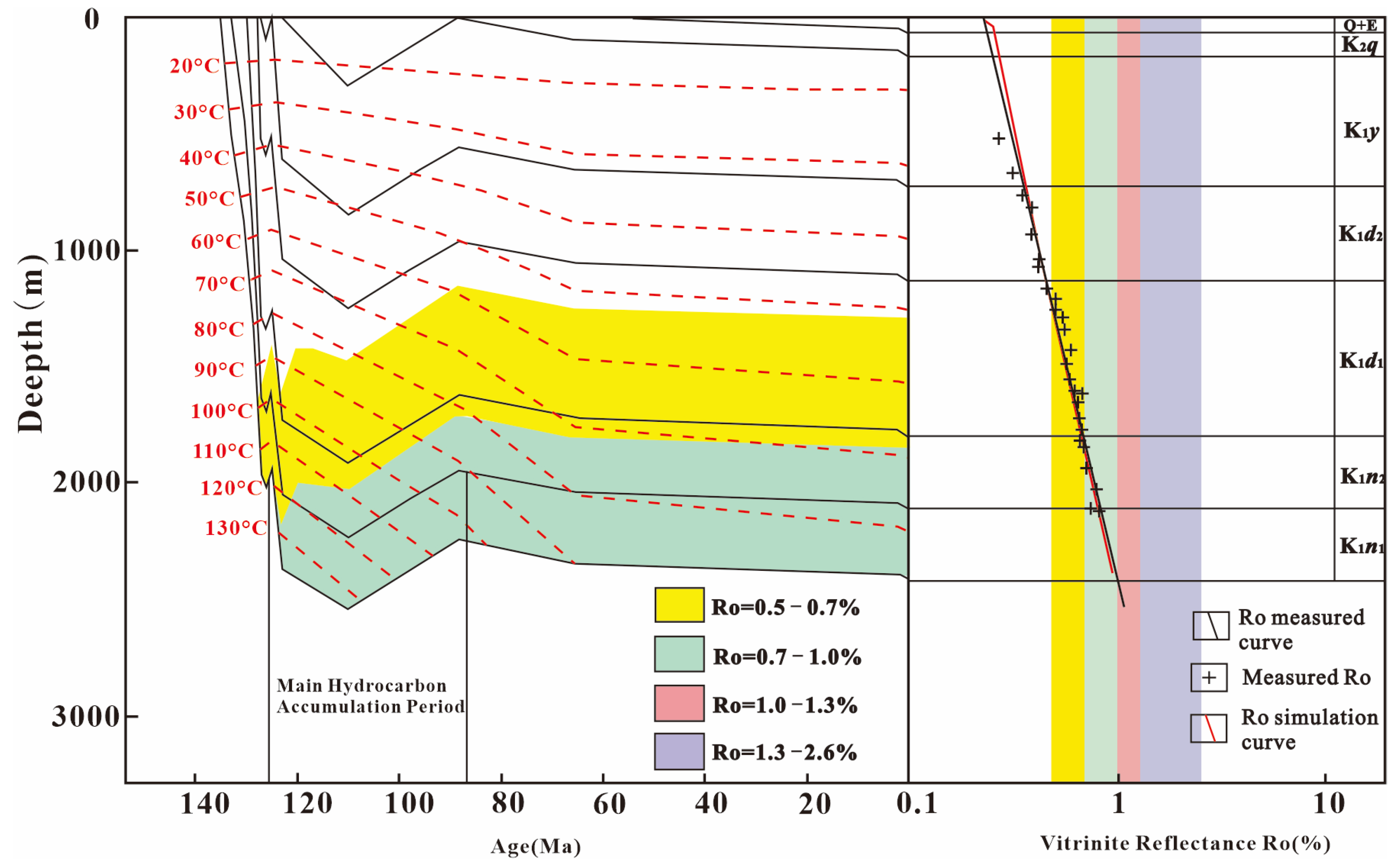
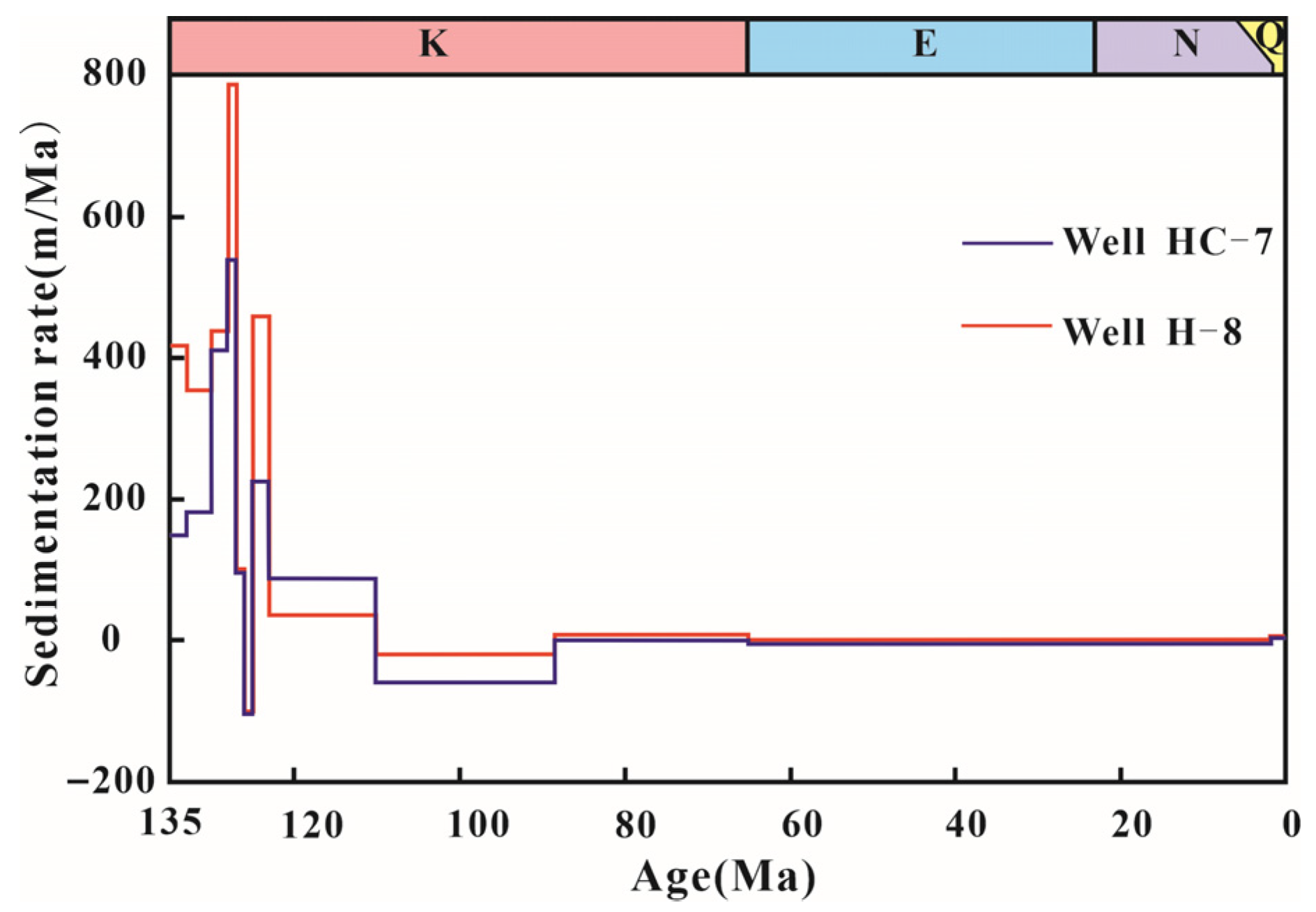
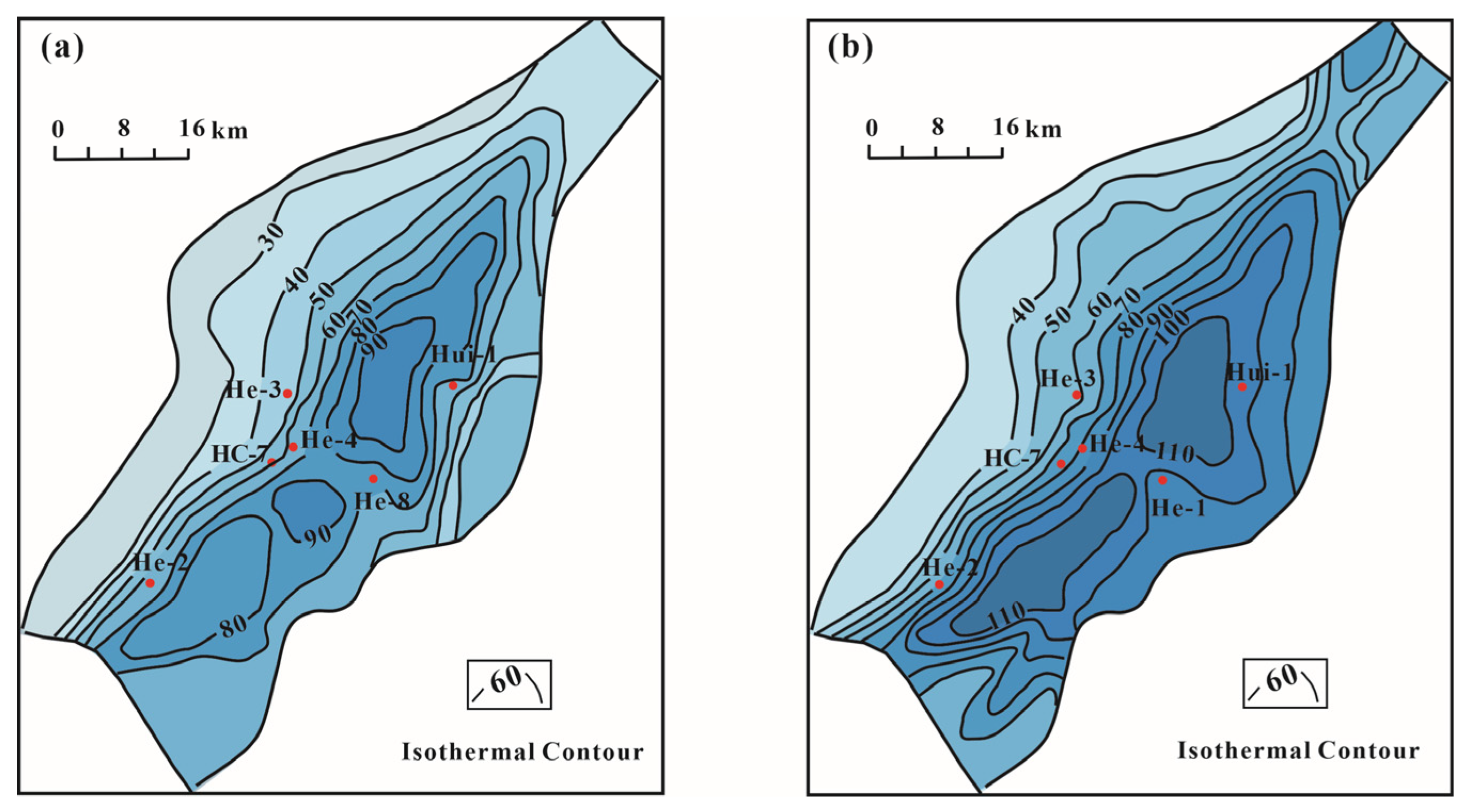
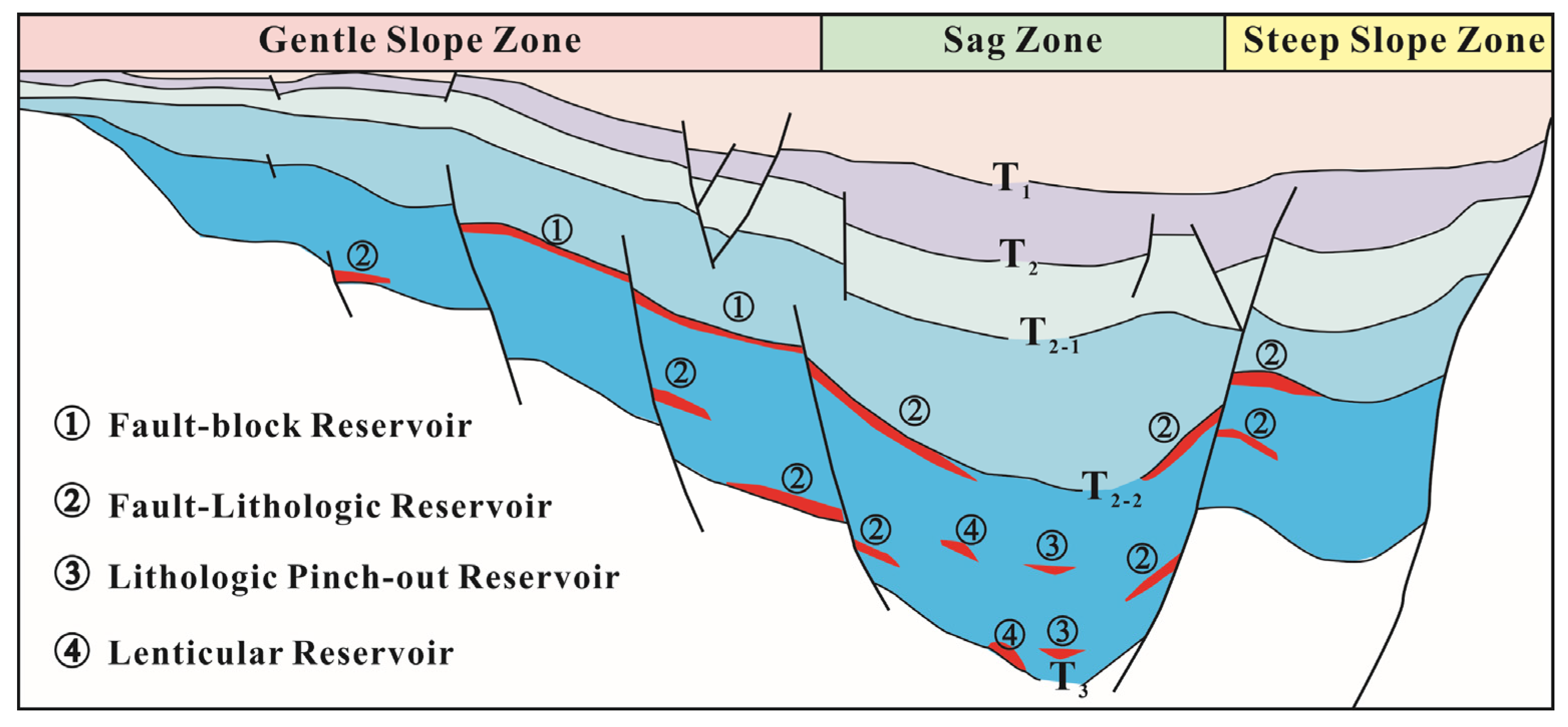
| Horizon | Present-Day | Top Yimin Fm | Top Damoguaihe Fm | |||
|---|---|---|---|---|---|---|
| Total Hydrocarbon Generation (108 t) | Hydrocarbon Expulsion Volume (108 t) | Total Hydrocarbon Generation (108 t) | Hydrocarbon Expulsion Volume (108 t) | Total Hydrocarbon Generation (108 t) | Hydrocarbon Expulsion Volume (108 t) | |
| K1d2 | 0.798 | 0 | 0.669 | 0 | 0.229 | 0 |
| K1d1 | 3.98 | 0.433 | 3.07 | 0 | 1.66 | 0 |
| K1n2 | 3.91 | 1.8 | 3.41 | 1.43 | 1.25 | 0 |
| K1n1 | 2.55 | 1.31 | 2.5 | 1.24 | 1.04 | 0.35 |
| Total | 11.2 | 3.55 | 9.65 | 2.67 | 4.19 | 0.35 |
| Depression | Well Number | Well Depth (m) | Horizon | Age (Ma) |
|---|---|---|---|---|
| Beier Depression | Huo-3 | 2023 | Tongbomiao Formation | 93.73 ± 2.0 |
| Huo-3 | 2023 | 98.74 ± 2.0 | ||
| Wuerxun Depression | Wu-11 | 1895 | 93.28 ± 2.0 | |
| Wu-11 | 1895 | 93.07 ± 2.0 | ||
| Su-6 | 1520 | Damoguaizi Formation | 94.87 ± 2.0 | |
| Su-6 | 1520 | 92.52 ± 2.0 | ||
| Hulun Lake Depression | HS-3 | 2076 | Tongbomiao Formation | 96.71 ± 2.0 |
| HS-3 | 2076 | 95.3 ± 2.0 | ||
| HS-3 | 1526 | Nantun Formation | 92.71 ± 2.0 | |
| HS-3 | 1526 | 94.5 ± 2.0 | ||
| Huhehu Depression | He-2 | 1646 | 96.67 ± 2.0 | |
| He-2 | 1646 | 96.14 ± 2.0 |
| Well | Depth (m) | Horizon | Lithology | Homogenization Temperature (°C) |
|---|---|---|---|---|
| He-1-1 | 1634.81~1641.18 | First Member of Damoguaihe Formation | Oil-bearing fine sandstone | 90, 92, 93, 94, 98, 155, 156, 157, 160, 163, 165, 170 |
| He-1-2 | 1845.13~1853.7 | Second Member of Nantun Formation | Sandstone | 88, 90, 92, 94, 95, 96, 98, 155, 157, 159, 160, 165, 167, 170 |
| He-2 | 1637.24~1655.1 | Second Member of Nantun Formation | Oil-impregnated coarse sandstone | 92, 96, 91, 99, 98, 100, 158, 159, 164, 166, 167, 170, 171, 175 |
Disclaimer/Publisher’s Note: The statements, opinions and data contained in all publications are solely those of the individual author(s) and contributor(s) and not of MDPI and/or the editor(s). MDPI and/or the editor(s) disclaim responsibility for any injury to people or property resulting from any ideas, methods, instructions or products referred to in the content. |
© 2025 by the authors. Licensee MDPI, Basel, Switzerland. This article is an open access article distributed under the terms and conditions of the Creative Commons Attribution (CC BY) license (https://creativecommons.org/licenses/by/4.0/).
Share and Cite
Cui, J.; Jin, W.; Ren, Z.; Song, H.; Liu, G.; Tao, H. Hydrocarbon Accumulation Stages in the Huhehu Sag, Hailar Basin, China. Energies 2025, 18, 5488. https://doi.org/10.3390/en18205488
Cui J, Jin W, Ren Z, Song H, Liu G, Tao H. Hydrocarbon Accumulation Stages in the Huhehu Sag, Hailar Basin, China. Energies. 2025; 18(20):5488. https://doi.org/10.3390/en18205488
Chicago/Turabian StyleCui, Junping, Wei Jin, Zhanli Ren, Haoyu Song, Guoqing Liu, and Hua Tao. 2025. "Hydrocarbon Accumulation Stages in the Huhehu Sag, Hailar Basin, China" Energies 18, no. 20: 5488. https://doi.org/10.3390/en18205488
APA StyleCui, J., Jin, W., Ren, Z., Song, H., Liu, G., & Tao, H. (2025). Hydrocarbon Accumulation Stages in the Huhehu Sag, Hailar Basin, China. Energies, 18(20), 5488. https://doi.org/10.3390/en18205488






